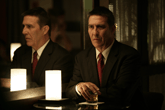During the Q&A, cinematographer Edward Lachman commented that the more aesthetic look to Life During Wartime with respect to Todd Solondz’s earlier work was a result of Solondz’s direction that the film convey a degree of unnaturalness and plasticity. On the surface, this image of conscious construction seems inconsistent with the sense of organic continuity achieved by revisiting characters (albeit transfigured) from Solondz’s earlier film, Happiness: a narrative progression existing outside the frame that is suggested in the in medias res opening sequence with neurotic couple, Allen (Michael K. Williams) and Joy (Shirley Henderson) celebrating their anniversary at a restaurant before having their romantic dinner scuttled when the waitress recognizes Allen’s voice as that of her obscene phone caller. As in Happiness, Life During Wartime is also interconnected by the three sisters’ unrequited search for happiness: Trish (Allison Janney) the divorced mother just returning to the dating scene after her ex-husband, Bill (Ciarán Hinds) was imprisoned for pedophilia; writer Helen (Ally Sheedy) whose persona ever teeters between mercurial artist and narcissistic celebrity; and fragile Joy who, still haunted by her jilted lover, Andy’s (Paul Reubens) suicide, decides to run away to Miami to re-evaluate her marriage. At the core of Solondz’s perversely wry satire is the nature – and limits – of forgiveness in its various incarnations, from crime and punishment, to moral transgression, to weakness and despair. Framed against the image of pervasive artificiality, Solondz creates an eccentric metaphor for longing as a manifestation of impossible construction, where only the prospect of redemption, not happiness, lies within our grasp.
© Acquarello 2009. All rights reserved.
